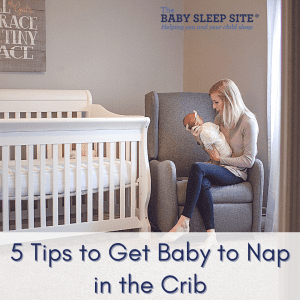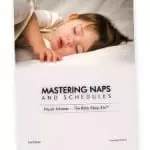
When your baby won’t nap in the crib, it can be a long, exhausting day for both of you. Your baby might take short naps or take long naps but only in your arms. It’s hard to get anything done having just 30 minutes or being confined to a chair while your baby sleeps. This post will explain why babies don’t nap in their cribs and give you 5 tips for getting baby to nap in the crib based on my 10+ years as a sleep consultant.
Why Won’t Baby Nap in the Crib?
There are usually a few reasons a baby won’t nap in their crib. Here are the top reasons:
Baby Only Sleeps in Arms
Many babies only want to sleep in your arms or chest. They were in your womb for many months and want to mimic that same safe environment. This is why babies love swaddling!
Baby Likes Movement
If your baby likes to be rocked to sleep or in a carrier, they may prefer to be moving when they sleep. Once you get them to sleep and lay them in the crib, they are no longer moving and can’t seem to stay asleep!
Baby Doesn’t Like to Sleep on Their Back
Your baby may not like sleeping flat on their back. Instead, your baby might prefer stomach sleeping or side sleeping. However, that’s not considered safe! You should always try to put your baby on their back to sleep, if possible. Be sure to follow all of the safe sleep tips.
Baby Takes a Short Nap Then Wakes Up
Your baby may sleep in the crib for a little while but then wakes up after a short nap! This is extremely common and usually, related to how they’ve gone to sleep in the first place. They don’t know how to go into the next sleep cycle without your help. We call these sleep associations
You May Also Be Interested In…
When to Start Naps in the Crib
When you have a newborn, typically, you’d have your baby nap in the common area so you can tend to them quickly. This is true especially if you’re still recovering from delivery. As your baby becomes more aware of the world, though, naps in the common area can be disruptive.
Therefore, it’s a good idea to start naps in the crib around 8-12 weeks old to 6 months old. It’s often easier to work on naps in the crib before they can sit up and/or stand up.
If your baby is older than this, it’s never too late to try to get them to nap in the crib! However, it often gets significantly harder at 18 months old or older.
How to Get Baby to Nap in the Crib – 5 Tips
Getting your baby to nap in the crib will take effort but since your baby will nap until 3 to 4 years old, on average, the effort is WELL worth it!
I work with parents a lot who don’t mind holding the baby the first few weeks or even the first few months. But, once your baby gets heavier, the newness of having a new baby wears off a bit, you have more to do around the house, your baby becomes mobile, etc. it becomes very difficult to sit for long periods of time holding the baby. And, every mama could use a break sometimes!
Don’t feel bad if you want your baby to nap in the crib. In most cases, it will pay off for both of you! They will be more rested and you will have a little time to do chores, work, or take a break.
Here are 5 tips to get baby to nap in the crib:
1. Spend Awake Time in the Crib
I know you want your baby to sleep in the crib but we have to start somewhere. First, get your baby used to the crib during awake playtime. You don’t want the crib to be a “foreign” place. In fact, you want it to be a comforting, welcoming place!
You can consider a crib mobile but consider some are meant to stimulate and some are meant to soothe. Be sure to buy the right kind of mobile to promote sleep and napping!
Also, be mindful that too much downtime in the crib can have the opposite problem. Your baby might equate the crib with playtime or, worse, cause insomnia or difficulty sleeping.
I recommend you spend around 8-10 minutes of awake time in the crib at least 2-3 times a day when you’re first starting out. Once your baby is napping in the crib, it is not usually necessary to continue doing playtime in the crib. But, of course, it doesn’t hurt either!
If your baby cries when placed in the crib, start with just 1-2 minutes at a time and work your way up. Be sure to interact with your baby by playing peek-a-boo, singing upbeat children’s songs, and just being silly sometimes!
2. Consider Swaddling
I can’t tell you how many parents come to me and say they are swaddling their baby at night but not during the day. They are worried about confusing the baby between day and night sleep. And, this is a reasonable worry! Newborns do have day / night confusion for several weeks until it’s sorted out.
However, once it is sorted out, your baby generally can’t confuse day and night even if they tried! Our circadian rhythms (aka internal clocks) handle all of that.
So, if your baby is younger than 6 months old, consider swaddling your baby for a bit longer even at nap time and especially if they still have a strong moro reflex.
3. Put Baby in the Crib Asleep
Another “baby step” (pun intended) you can try is putting your baby in the crib already asleep. If you are rocking or feeding your baby to sleep, for example, do so, and then wait approximately 10 minutes until you can lift their arm and it drops down like a log. No resistance or your baby “catching it.”
Once they are asleep, put them down gently into the crib, feet touching first and at an angle, so you don’t activate the feeling of falling. Once laid down, put a hand on them gently to make sure they stay asleep. If necessary, pat or rub them gently while shushing to keep them asleep.
4. Create a Nap Sleep Routine
Most people create a bedtime routine fairly early but don’t think about creating a routine for naptime. But, a nap routine can prepare your baby for sleep just as it does at night!
Nap sleep routines, however, should not be very long. They are usually approximately 5-10 minutes long, possibly a little longer if your baby’s schedule is set to have a feeding before naps rather than a more customary eat-play-sleep routine.
Your nap routine can be simple. Here is an example:
- Go to the nursery and close the blinds/curtains.
- Change your baby’s diaper (if applicable.)
- Read 1 or 2 board books.
- Turn on the white noise and turn off the light.
- Hum or sing while swaying or rocking for 3-5 minutes.
- Lay your baby down in the crib.
If your baby cries when being put in the crib, we’ll work on that in a step below, don’t worry!
5. Start Sleep Training
If you put your baby all the way to sleep, put them in the crib, and they take great naps, there’s nothing you need to change!
However, if your baby wakes up as soon as you put them down to sleep and/or takes a short nap, then you typically need to change the end of the routine and put baby down AWAKE. Again, this is due to sleep associations that I mentioned above. If your baby needs your help to fall asleep, they will struggle to go BACK to sleep without help. That can lead to short naps or skipping naps altogether.
If your baby cries when put in the crib awake, I know this can be troubling. Change can be hard for all of us and we don’t blame them! But, just like all people, we can adapt to a new way of doing something with enough time and practice.
When your baby is crying, your intuition is to fix it right away. Understandable!
Even if your baby is unhappy about changing your routine of putting them down awake, you can help them see this as their new “normal” in no time.
Nap training generally takes approximately 2 weeks of sleep training to accomplish with the first 4-5 days usually being the hardest. Once your baby has a few successful naps in the crib, they will see it’s not as bad as they thought!
Keep in mind that people often equate “sleep training” with “cry it out” but that couldn’t be further from the truth. There are gentle ways to teach your baby to sleep on their own (see below). It just takes some time and effort on your part.
Consistency is key as with any new habit you’re trying to make. We have hundreds of articles on this site about getting better sleep for your baby. If you’re ready to bypass a bunch more reading, consider buying Mastering Naps & Schedules with over 40 sample schedules for your little one. Or, feel free to continue reading more about naps on our blog.
You May Also Be Interested In…






